|
Thousand Pillar Temple


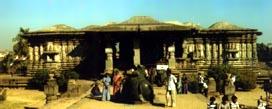 |
0.4 kms from Hanamkonda
cross-road the temple is a fine specimen of Kakatiya architecture
and sculpture, the Thousand Pillar temple as the name implies has many
pillars, all efficient carved.The temple is built in Chalukyan Style. The
Nandi here has beautifulfinishing. |
| |
Warangal Fort



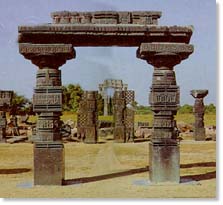 |
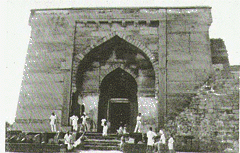 |
|
12km from Hanamkonda, was constructed by King Ganapathi in 1199 A.D. and
completed by
his daughter Rudrama in 1261 A.D., the fort has two walls, with the
tracesf the third.
Places of interest in
the fort area temple, and four thoranas or gateways, similar to those at
Sanchi, signifying the Buddhist influence. |
|
Bhadrakali Temple



|
The important attraction in this temple is the idol of the deity in sitting
posture with her eight hands filled
with weapons. The head of the idol is adorned by a crown.
|
GHANPUR TEMPLE

 
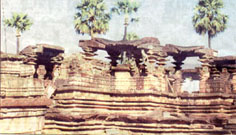 |
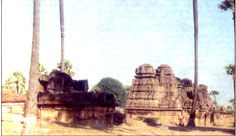 |
|
Ghanpur, the important grain producing center of Warangal district boasts
of an impressive temple architecture consisting of about 20 temples in various designs and sizes.
Locally known as "Kota Gullu", the
temple complex is a veritable museum of the Kakatiya temple architecture
built during the 13th century AD.
It is believed that Ghanpur got its name from the Pramadha Ganas or demigods
who occupied an important
place in the huge temple complex. Exposed to the vagaries of nature and
continuous battles, the temple
complex is in a dilapidated condition but speaks volumes of the architectural
proficiency of the Kakatiyas.
How far? How to go and where to stay?
The temple complex at Ghanpur lies 74 kilometers from Warangal town and
7 kilometers from the famous
Ramappa temple in Palampet. The place is well connected by buses from Warangal
and Hanumakonda.
Private taxis can also be arranged. Accommodation is available in hotels
and small guest houses at Warangal
and Hanumakonda.
What to see?
The unique architectural sense of the Kakatiyas is worth seeing and appreciating
at Ghanpur.
The
Kakatiyas were as much devoted to their people as to the Gods. Wherever
they created lakes for irrigation
purposes, a temple was also constructed.
The Bhadrakali temple beside the
Bhadrakali lake and the
Ramappa temple adjacent to the Ramappa lake are fine examples. Similarly,
the Ghanpur temple is built near
the Ghanpur lake about 5 square miles in area.
Encompassed by a ruined wall, the Ghanpur temple complex has two big temples
in the center, along with a
pillared hall and about 17 smaller shrines all around.
Built with a combination
of red, green and black stones,
the temple complex is dedicated to Lord Shiva and his consort, Parvathi.
In the front of the sanctum
sanctorum of the main temple, there is a Nandi in black stone. The other
smaller shrines around the temple
were probably built to house the demigods.
The temples are built in typical Hindu temple architecture consisting of
a sanctum sanctorum (garbha griha),
inner space in between (antaraala) and an assembly hall (sabha mandapa).
While some temples are square in
form, others resemble a "plus" sign when viewed from the top. This is so
because the garbha griha and
antaraala are in one direction and the several pillared sabha mandapa with
excellent sculptures is spread in all
the three directions.
The primary temple in the complex has a slight variation with exquisite
sculptures on the pillars of the sabha
mandapa and intricate carvings on the inside walls of the garbha griha.
It, therefore, presents a star shape
when seen aerially.
A unique feature of the Kakatiyan architecture is that the pillars of the
temples are square in the lower
portion, cylindrical in the center and plate-like at the top.
Madanikas
or graceful female figurines connected
to the pillars, support the roof on top.
About 10 yards from the primary
temple is an exclusive star-shaped
sabha mandapa with sixty aesthetically carved pillars spread over
2500 square feet.
There are elaborate
carvings on the temple walls and pillars which is typical of the
Kakatiyan style of temple architecture.
The splendid architecture and pleasant ambience within the temple complex
is what makes Ghanpur worth
visiting. Well preserved for posterity, Ghanpur is a fine example of ancient
temple architecture.
|
|
Pakal Wild Life Sanctuary



|
Pakal Wild Life Sanctuary was declared as a sanctuary by the erstwhile Hyderabad Government, because of itís rich bio-diversity.
This sanctuary encloses a lake, which was constructed by Pratapa Rudra, a Kakatiya ruler in 1323. The sanctuary is named after this lake.
The landscape appears extremely beautiful and captivating. It is a place worth visiting for itís natural scenic beauty. It extends over an area of 860 sq. km.
Fauna: Spotted Dear, Sambhar, Nilghai, Wild Boar, Guar, Python, Wild Dogs, Foxes, Jackals, Hyena, Sloth Bear, Panther, Tiger, Ducks, Teals, Cormorant, Spoon Bills, Storks etc
Flora:Dry Deciduous Mixed Type of Forests, Bamboo and Mixed Teak Forests.
Best Season To Visit:November to June.
How to reach:Pakhal wildlife sanctuary is located in Warangal district of Andhra Pradesh.
By Road:It lies on Narsampet-Warangal division, which is at a distance of 60km from Warangal. Pakhal is 130km by road from Hyderabad.
By Rail:The nearest Railway station is Warangal.
|
|
Eturunagaram Wild Life



|
Area: 803 Sq. km
Animal found:
Spotted deer, black buck, sambhar, nilgai, chowsingha, muntjac, wild boar, guar, jungle cat, jackals, foxes, wolves, sloth bear, panther, tiger and variety of other birds
Habitat:
Dry deciduous mixed teak forest with bamboo & other species on rolling countrysides with low hills.
Location :
District - Warangal, Mulag- Warangal North Forest Division 80 km from Kazipet Junction. (S.C.Railway) and Warangal Town
How to get Eturunagaram
Rail:Nearest Railway Station is at Warangal.
Road:from Hyderabad 130 km Well connected by state buses.
Where to Stay :Forest cottages at Tadvai and Eturnagaram.
Contact :Divisional Forest Officer, Wildlife Management , Warangal.
Best Season : October to May
|
|
Brassware of Pembarthi


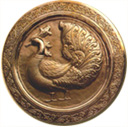
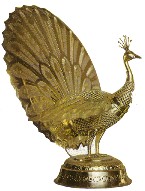
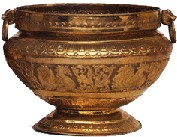
|
Pembarthy is 100Km from Hyderabad on State Highway to Warangal. The brassware of Pembarthy is world famous.
The air resounds with the continous clink and tap of mallets beating out brass sheets into fascinating and wonderful objects of art and utility.
Originally stone carvers, the artists have left their handiwork in the facades of innumerable stone carvings and temples all over India. Then when brass became common, they experimented with this material. The buildings of Vijayanagar at Hampi are ruins
now, but their lower stories were sheathed in beaten copper and brass by the ancestors of the Pembarthi craftsmen. For some reason this widespread craft has survived only at the sleepy little village of Pembarthi.
Scholars tell us of a previous age when iron was not known and copper and alloys were used for making metal tools and objects of daily use. A small part of that age is still with us but mostly in objects of art.
Statues, carvings, castings still continue to be made in the attractive copper alloys like bronze and brass. The methods used are still ancient, traditional ones although the raw material today comes from modern mines and furnaces.
Indian brass is renowned the world over and chances are the brass potted planter in the foyer of a Manhattan hotel or Tokyo corporate office comes from Pembarti, a small village of Andhra Pradesh which is a centre of brass work.
Brass lotas, large globular vessels and plates were in demand even up to the beginning of this century. But as time went on the market died out for these.
In recent times, tired of mass-produced dully uniform items, customers from affluent countries started noticing the unique Pembarthi craftsmanship. Now, as an example, brass and copper planters are prized. The Pembarthi designs are quite different from , say Moradabad or Benares brassware although the material is the same -- factory made brass sheeet.
Innovative architects started using Pembarthi brassware in their designs as a integral whole rather than piecemeal "items" of furniture. This has led to a revival of the craft tradition.
|
|
|